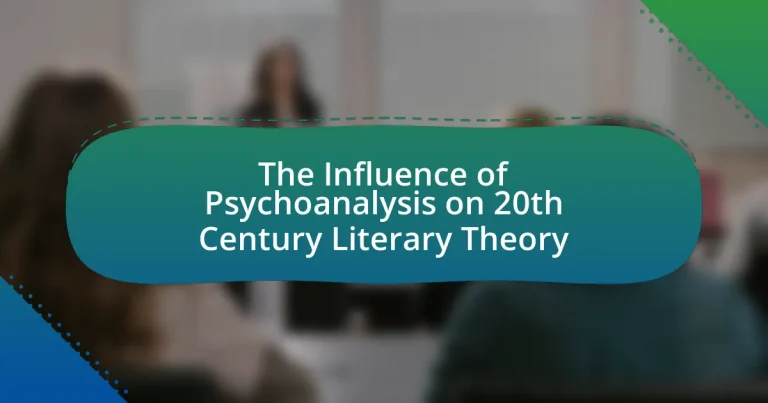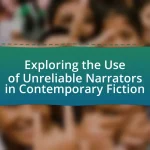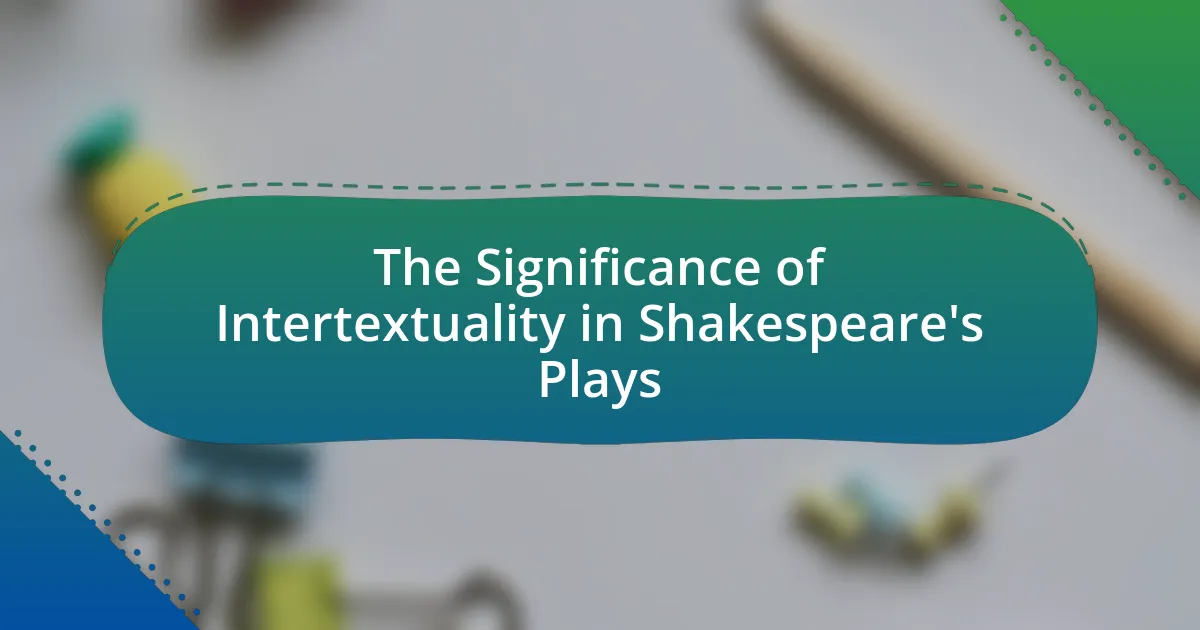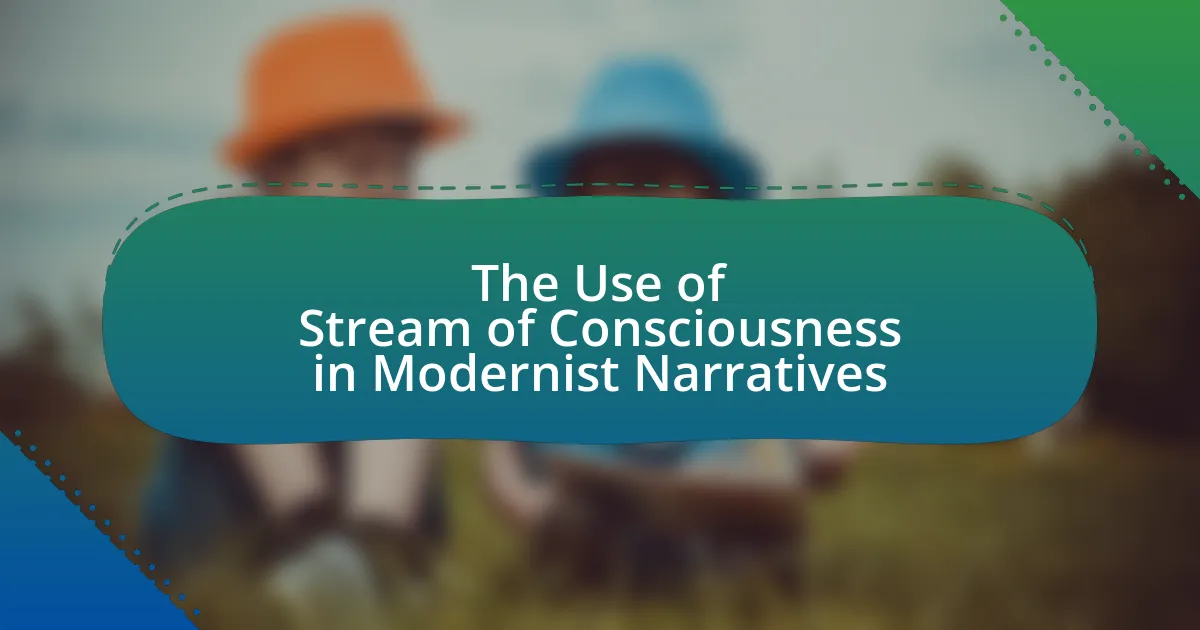The article examines the profound influence of psychoanalysis on 20th-century literary theory, highlighting key concepts such as the unconscious, repression, and the interpretation of dreams. It discusses how figures like Sigmund Freud and Jacques Lacan shaped literary criticism, enabling deeper analysis of character motivations and narrative structures. The article also explores the emergence of psychoanalytic criticism, its foundational theories, and its impact on literary movements like modernism and surrealism, as well as contemporary implications in literary analysis. Key psychoanalytic themes in works by authors such as James Joyce and Virginia Woolf are analyzed, demonstrating the interplay between psychological theory and literature.
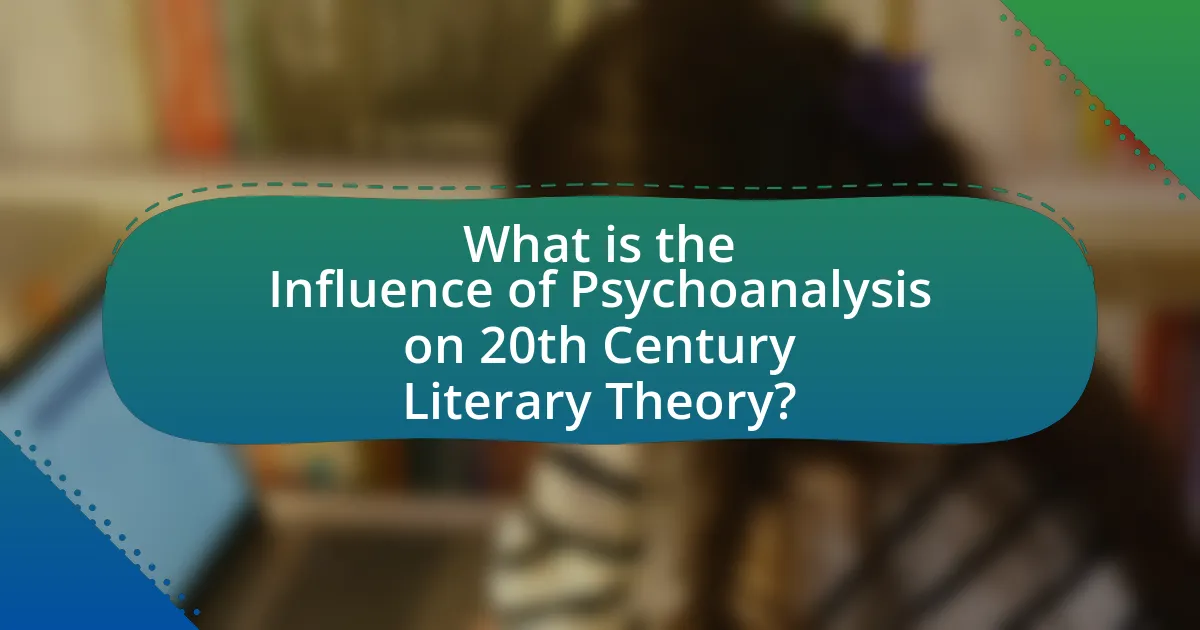
What is the Influence of Psychoanalysis on 20th Century Literary Theory?
Psychoanalysis significantly influenced 20th-century literary theory by introducing concepts such as the unconscious, repression, and the interpretation of dreams, which reshaped the understanding of character motivation and narrative structure. Key figures like Sigmund Freud and later Jacques Lacan provided frameworks that allowed literary critics to analyze texts through the lens of psychological conflict and desire, emphasizing the complexities of human behavior and the symbolic nature of language. This shift is evident in the works of authors such as James Joyce and Virginia Woolf, who employed stream-of-consciousness techniques to explore the inner workings of their characters’ minds, reflecting psychoanalytic ideas. The incorporation of psychoanalytic theory into literary criticism led to new methodologies, such as psychoanalytic criticism, which examines the psychological dimensions of literature, thereby enriching the analysis of texts and their meanings.
How did psychoanalysis emerge as a significant influence in literary theory?
Psychoanalysis emerged as a significant influence in literary theory primarily through the introduction of Freudian concepts, which provided new frameworks for understanding character motivations and narrative structures. Sigmund Freud’s theories, particularly those concerning the unconscious mind, repression, and the interpretation of dreams, resonated with literary critics and writers in the early 20th century, leading to a deeper exploration of psychological dimensions in literature. This influence was evident in the works of authors such as James Joyce and Virginia Woolf, who incorporated psychological depth into their narratives, reflecting the complexities of human consciousness. Furthermore, the establishment of psychoanalytic criticism as a formal approach in literary studies, notably through figures like Jacques Lacan, solidified its role in analyzing texts, emphasizing the interplay between literature and psychological theory.
What are the foundational concepts of psychoanalysis relevant to literature?
The foundational concepts of psychoanalysis relevant to literature include the unconscious mind, repression, and the Oedipus complex. The unconscious mind, as proposed by Sigmund Freud, suggests that hidden thoughts and desires influence behavior and creativity, impacting character development and narrative structure in literature. Repression refers to the process of suppressing unwanted thoughts, which can manifest in literary themes of conflict and identity. The Oedipus complex, a key Freudian theory, explores familial relationships and desires, often reflected in character dynamics and plotlines. These concepts have significantly shaped literary analysis and interpretation, as seen in works by authors like James Joyce and Virginia Woolf, who incorporated psychological depth into their characters and narratives.
How did key figures in psychoanalysis contribute to literary theory?
Key figures in psychoanalysis, such as Sigmund Freud and Jacques Lacan, significantly contributed to literary theory by introducing concepts that explore the unconscious mind, desire, and the complexities of human behavior in texts. Freud’s theories, particularly the notions of repression, the Oedipus complex, and dream interpretation, provided a framework for analyzing characters and narratives, allowing critics to uncover deeper psychological meanings within literature. Lacan expanded on Freud’s ideas by emphasizing language and the symbolic order, which influenced post-structuralist approaches to texts, highlighting how meaning is constructed and deconstructed through language. These psychoanalytic frameworks have been instrumental in shaping critical methodologies, enabling scholars to examine literature not just as a reflection of reality but as a complex interplay of psychological forces.
Why is the relationship between psychoanalysis and literature important?
The relationship between psychoanalysis and literature is important because it provides a framework for understanding the psychological motivations behind characters and narratives. Psychoanalysis, founded by Sigmund Freud, offers insights into the unconscious mind, which can be reflected in literary themes, character development, and narrative structures. For instance, Freud’s theories on repression and the Oedipus complex have influenced literary analysis, allowing critics to explore deeper meanings in texts, such as the exploration of identity and desire. This interplay enriches both fields, as literature can illustrate psychoanalytic concepts while psychoanalysis can deepen the understanding of literary works.
What insights does psychoanalysis provide into character development?
Psychoanalysis provides insights into character development by emphasizing the influence of unconscious motivations and early childhood experiences on behavior. This framework suggests that characters are shaped by repressed desires, conflicts, and traumas, which can manifest in their actions and relationships. For instance, Sigmund Freud’s theories highlight how unresolved Oedipal complexes or fixation at certain psychosexual stages can lead to specific character traits and interpersonal dynamics. Additionally, the exploration of defense mechanisms, such as repression or projection, reveals how characters cope with internal conflicts, further enriching their complexity and realism in narratives.
How does psychoanalysis enhance the understanding of narrative structure?
Psychoanalysis enhances the understanding of narrative structure by revealing the underlying psychological motivations and conflicts of characters, which shape the plot and themes. This approach allows for a deeper analysis of character development and the dynamics of the narrative, as seen in works like James Joyce’s “Ulysses,” where stream-of-consciousness techniques reflect the characters’ inner thoughts and desires. Furthermore, psychoanalytic concepts such as repression and the unconscious provide frameworks for interpreting narrative techniques, such as flashbacks and unreliable narration, which can illustrate the complexities of human experience and emotional truth.
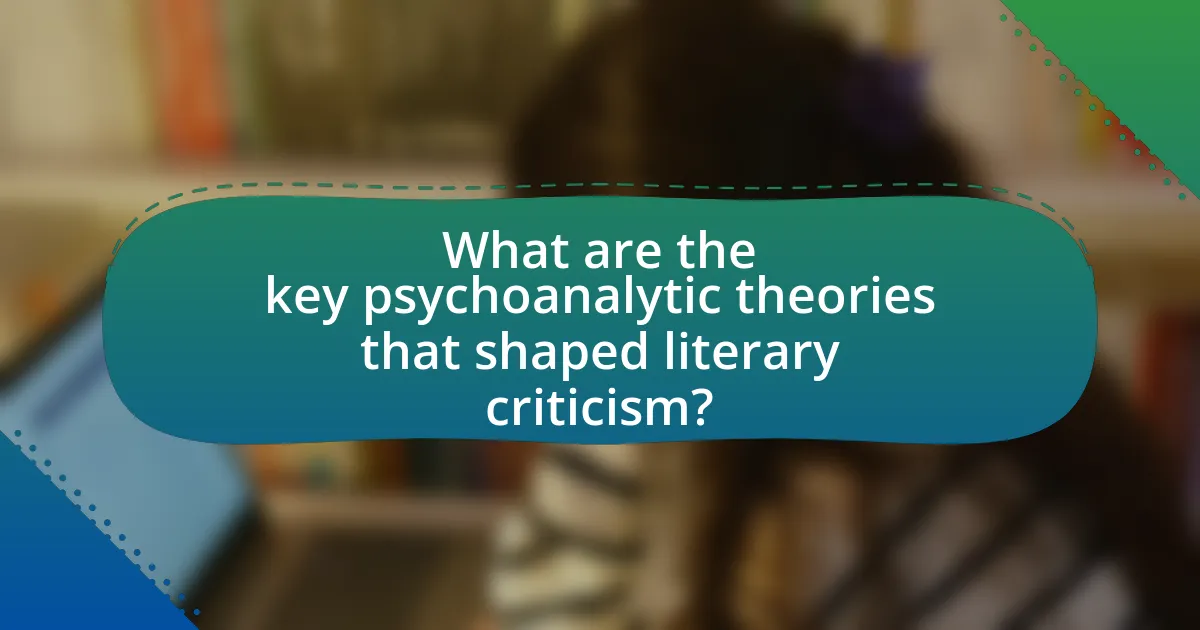
What are the key psychoanalytic theories that shaped literary criticism?
Key psychoanalytic theories that shaped literary criticism include Freudian psychoanalysis, Jungian psychology, and Lacanian theory. Freudian psychoanalysis, developed by Sigmund Freud, emphasizes the role of the unconscious mind, repression, and the Oedipus complex, influencing critics to explore characters’ motivations and desires. Jungian psychology, founded by Carl Jung, introduces concepts such as archetypes and the collective unconscious, prompting literary critics to analyze universal symbols and themes across texts. Lacanian theory, based on Jacques Lacan’s reinterpretation of Freud, focuses on language, desire, and the symbolic order, leading to critiques that examine how language shapes identity and meaning in literature. These theories have profoundly impacted the interpretation of texts, allowing for deeper psychological insights into characters and narratives.
How did Freudian theory influence literary analysis?
Freudian theory significantly influenced literary analysis by introducing concepts such as the unconscious mind, repression, and symbolism, which allowed critics to explore deeper psychological motivations behind characters and narratives. This approach enabled a new understanding of texts, where literature was seen as a reflection of the author’s psyche and societal norms. For instance, the application of Freudian concepts in works by authors like James Joyce and Virginia Woolf revealed complex character motivations and themes of desire and conflict, illustrating how psychoanalytic criticism could uncover layers of meaning that traditional analysis might overlook.
What are the main Freudian concepts applied in literary criticism?
The main Freudian concepts applied in literary criticism include the unconscious, repression, and the Oedipus complex. The unconscious refers to the part of the mind that houses desires and memories not accessible to conscious awareness, influencing characters and narratives in literature. Repression involves the exclusion of distressing thoughts and feelings from consciousness, often manifesting in themes of conflict and tension within literary works. The Oedipus complex describes a child’s unconscious desire for the opposite-sex parent and rivalry with the same-sex parent, which can be reflected in character relationships and plot dynamics. These concepts provide a framework for analyzing texts, revealing deeper psychological meanings and motivations behind characters’ actions and authors’ intentions.
How do Freudian themes manifest in 20th-century literature?
Freudian themes manifest in 20th-century literature through the exploration of the unconscious mind, repression, and the complexities of human sexuality. Authors such as James Joyce and Virginia Woolf employed stream-of-consciousness techniques to delve into characters’ inner thoughts, revealing their subconscious desires and fears. For instance, Joyce’s “Ulysses” illustrates the internal conflicts and repressed emotions of its characters, aligning with Freud’s theories on the psyche. Additionally, the theme of the Oedipus complex appears in works like D.H. Lawrence’s “Sons and Lovers,” where familial relationships and sexual tensions are central to character development. These manifestations demonstrate the profound impact of Freudian psychoanalysis on narrative structure and character psychology in 20th-century literature.
What role does Jungian analysis play in literary theory?
Jungian analysis plays a significant role in literary theory by providing a framework for understanding archetypes and the collective unconscious in literature. This approach allows critics and scholars to analyze characters, themes, and narratives through the lens of universal symbols and shared human experiences. For instance, Jung’s concept of archetypes, such as the Hero or the Shadow, helps in interpreting the motivations and transformations of characters across various texts, revealing deeper psychological truths. Additionally, Jungian analysis emphasizes the importance of dreams and myths in literature, suggesting that these elements reflect the inner workings of the psyche and cultural narratives. This perspective has influenced notable literary theorists, such as Northrop Frye, who integrated Jungian concepts into his analysis of literature, demonstrating the enduring impact of Jungian thought on the field.
What are the core Jungian concepts relevant to literature?
The core Jungian concepts relevant to literature include archetypes, the collective unconscious, and individuation. Archetypes are universal symbols and themes that recur across cultures and time, influencing character development and narrative structures in literature. The collective unconscious refers to the shared reservoir of experiences and memories that shape human behavior and creativity, allowing authors to tap into common human experiences in their works. Individuation is the process of personal development and self-realization, which can be reflected in character arcs and thematic explorations in literary texts. These concepts provide a framework for understanding the psychological depth and symbolic meaning in literature, as evidenced by the works of authors like Hermann Hesse and James Joyce, who incorporated Jungian ideas into their narratives.
How does Jungian archetype theory influence character analysis?
Jungian archetype theory significantly influences character analysis by providing a framework for understanding universal symbols and themes that resonate across cultures and narratives. This theory posits that archetypes, such as the Hero, the Shadow, and the Anima/Animus, serve as foundational elements in storytelling, allowing analysts to identify and interpret character motivations and behaviors in a deeper context. For instance, characters embodying the Hero archetype often undergo transformative journeys, reflecting collective human experiences and psychological growth. This analytical approach is supported by Jung’s assertion that these archetypes emerge from the collective unconscious, making them relevant in various literary works. Consequently, character analysis becomes enriched by recognizing these archetypal patterns, leading to a more profound comprehension of both individual characters and the narratives they inhabit.

How did psychoanalysis impact specific literary movements in the 20th century?
Psychoanalysis significantly influenced various literary movements in the 20th century, particularly modernism and surrealism. Modernist writers, such as Virginia Woolf and James Joyce, incorporated psychoanalytic concepts like the unconscious and stream of consciousness to explore complex human emotions and inner experiences. For instance, Woolf’s “Mrs. Dalloway” employs interior monologue to reveal characters’ psychological states, reflecting Freudian ideas about the mind. Surrealism, led by figures like André Breton, utilized psychoanalytic principles to unlock the unconscious mind, emphasizing dreams and irrationality as sources of artistic inspiration. The surrealists aimed to challenge conventional narratives and societal norms, aligning with Freud’s theories on repression and desire. These movements collectively demonstrate how psychoanalysis reshaped literary techniques and thematic explorations in the 20th century.
What influence did psychoanalysis have on Modernism?
Psychoanalysis significantly influenced Modernism by introducing concepts of the unconscious mind, which reshaped narrative techniques and character development in literature. Writers such as James Joyce and Virginia Woolf incorporated psychoanalytic ideas, exploring inner thoughts and fragmented realities, reflecting the complexities of human psychology. This shift is evident in works like Joyce’s “Ulysses,” where stream-of-consciousness techniques reveal characters’ subconscious motivations, and Woolf’s “Mrs. Dalloway,” which delves into the intricacies of time and perception. The integration of psychoanalytic theory allowed Modernist authors to challenge traditional narrative forms and explore deeper psychological truths, marking a departure from realism and contributing to the evolution of literary expression in the 20th century.
How did Modernist writers incorporate psychoanalytic ideas?
Modernist writers incorporated psychoanalytic ideas by exploring the unconscious mind, fragmented narratives, and character psychology. They utilized techniques such as stream of consciousness to reflect inner thoughts and emotions, as seen in works by James Joyce and Virginia Woolf. These authors drew on Sigmund Freud’s theories, particularly the concepts of repression and the id, ego, and superego, to depict complex human experiences. For instance, in “Ulysses,” Joyce illustrates the protagonist’s internal conflicts and desires, aligning with Freudian analysis of the psyche. This integration of psychoanalytic concepts allowed Modernist literature to delve deeper into human consciousness, challenging traditional narrative forms and emphasizing subjective experience.
What are examples of psychoanalytic themes in Modernist literature?
Examples of psychoanalytic themes in Modernist literature include the exploration of the unconscious mind, the use of dream symbolism, and the examination of identity and repression. Works such as James Joyce’s “Ulysses” delve into the stream of consciousness technique, revealing characters’ inner thoughts and desires, which aligns with Freudian concepts of the unconscious. Virginia Woolf’s “Mrs. Dalloway” employs fragmented narrative to illustrate the complexities of mental states and the impact of past traumas, reflecting psychoanalytic ideas about memory and identity. Additionally, T.S. Eliot’s “The Waste Land” incorporates disjointed imagery and allusions to psychological states, emphasizing themes of alienation and existential despair, which resonate with psychoanalytic interpretations of modern life. These examples demonstrate how Modernist literature engages with psychoanalytic themes to deepen the understanding of human psychology.
How did psychoanalysis shape Postmodern literary theory?
Psychoanalysis significantly shaped Postmodern literary theory by introducing concepts such as the unconscious, fragmentation, and the instability of meaning. These ideas influenced authors and theorists to explore the complexities of identity and subjectivity, leading to narratives that often reflect disjointed realities and multiple perspectives. For instance, the works of writers like Thomas Pynchon and Don DeLillo exemplify this influence, as they incorporate fragmented narratives and unreliable narrators, echoing psychoanalytic themes of repression and desire. Additionally, theorists like Jacques Lacan reinterpreted Freud’s ideas, emphasizing language’s role in shaping the unconscious, which further informed Postmodern critiques of representation and meaning in literature.
What are the key psychoanalytic critiques of Postmodernism?
Key psychoanalytic critiques of Postmodernism focus on its rejection of universal truths and the fragmentation of identity. Psychoanalysts argue that Postmodernism’s emphasis on relativism undermines the stability of the self, which is central to psychoanalytic theory. For instance, theorists like Julia Kristeva and Lacan highlight how Postmodernism’s deconstruction of narratives leads to a disintegration of the subject, challenging the notion of a coherent identity that psychoanalysis seeks to understand. Additionally, the critique posits that Postmodernism’s playful irony and pastiche can obscure deeper psychological truths, making it difficult to address the unconscious motivations that drive human behavior. This perspective emphasizes the need for a more grounded understanding of identity and subjectivity, which psychoanalysis aims to provide.
How do Postmodern texts reflect psychoanalytic concepts?
Postmodern texts reflect psychoanalytic concepts by exploring fragmented identities, unconscious desires, and the instability of meaning. These texts often employ techniques such as metafiction and unreliable narration, which mirror the psychoanalytic focus on the complexities of the human psyche. For instance, works by authors like Thomas Pynchon and Don DeLillo illustrate how characters grapple with their fragmented selves, echoing Freud’s theories on the unconscious and repression. Additionally, the emphasis on intertextuality in postmodern literature aligns with Lacan’s ideas about the symbolic order and the formation of identity through language. This connection between postmodern narrative strategies and psychoanalytic theory demonstrates how literature can serve as a medium for examining the intricacies of human consciousness and identity.
What are the contemporary implications of psychoanalysis in literary theory?
Contemporary implications of psychoanalysis in literary theory include the exploration of unconscious motivations and the interpretation of texts through psychological frameworks. Psychoanalytic criticism allows for a deeper understanding of character development, narrative structure, and thematic elements by examining the psychological states of both authors and characters. For instance, the application of Freudian concepts, such as repression and the Oedipus complex, can reveal underlying tensions and conflicts within literary works. Additionally, contemporary theorists like Julia Kristeva and Lacanian scholars have expanded psychoanalytic approaches to include issues of identity, gender, and cultural context, thereby enriching literary analysis. This evolution demonstrates that psychoanalysis remains a vital tool for dissecting the complexities of literature and human experience.
How is psychoanalysis being reinterpreted in current literary criticism?
Psychoanalysis is being reinterpreted in current literary criticism by emphasizing its application to diverse narratives and cultural contexts, moving beyond traditional Freudian frameworks. Contemporary critics analyze texts through lenses such as postcolonial theory, feminist theory, and queer theory, which expand the understanding of the unconscious and subjectivity in literature. For instance, scholars like Elizabeth Wright in “Psychoanalytic Criticism: Theory and Practice” (1998) argue that integrating psychoanalytic concepts with these theories allows for a richer interpretation of character motivations and societal influences. This shift reflects a broader trend in literary studies that seeks to incorporate multiple perspectives, thereby enriching the discourse surrounding psychoanalysis and its relevance in analyzing modern literature.
What are the challenges of applying psychoanalysis to modern literature?
Applying psychoanalysis to modern literature presents several challenges, primarily due to the evolving nature of literary forms and the complexity of contemporary psychological theories. One significant challenge is the divergence between classical psychoanalytic concepts, such as those proposed by Freud, and the multifaceted narratives found in modern literature, which often incorporate diverse cultural and social contexts that Freud’s theories do not fully address. Additionally, the subjective interpretation inherent in psychoanalysis can lead to varied readings of texts, complicating the establishment of a unified analytical framework. Furthermore, modern literature frequently employs non-linear storytelling and fragmented narratives, which can resist traditional psychoanalytic interpretations that rely on coherent character motivations and linear progression. These factors collectively hinder the straightforward application of psychoanalytic principles to contemporary literary analysis.
What practical approaches can be taken when analyzing literature through a psychoanalytic lens?
Practical approaches to analyzing literature through a psychoanalytic lens include character analysis, exploring unconscious motivations, and examining symbols and themes. Character analysis involves delving into the psychological complexities of characters, revealing their inner conflicts and desires, which can be informed by Freudian concepts such as repression and the Oedipus complex. Exploring unconscious motivations allows readers to uncover hidden desires and fears that drive characters’ actions, often reflecting broader societal issues. Examining symbols and themes, such as dreams or familial relationships, can provide insight into the collective unconscious, as proposed by Carl Jung, highlighting how literature reflects psychological archetypes and cultural narratives. These approaches are validated by the extensive application of psychoanalytic theory in literary criticism, as seen in works by scholars like Norman Holland and Julia Kristeva, who demonstrate the relevance of psychoanalysis in understanding literature’s deeper meanings.
